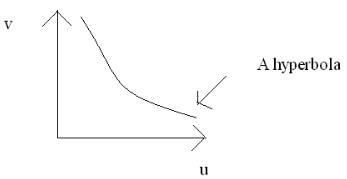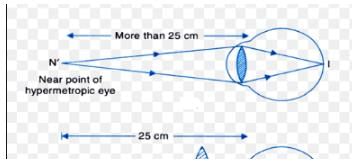Test: Ray Optics & Optical Instruments - 1 - JEE MCQ
30 Questions MCQ Test - Test: Ray Optics & Optical Instruments - 1
The graph drawn with object distance along abscissa & image as ordinate for a convex lens is
A lens of power + 2.0 D is placed in contact with another lens of power – 1.0 D. The combination will behave like
A short pulse of white light is incident from air to a glass slab at normal incidence. After travelling through the slab, the first colour to emerge is
According to Cartesian sign convention.
At the minimum deviation Dm, the refracted ray inside the prism
An observer looks at a tree of height 15 metre with a telescope of magnifying power 10. To him, the tree appears
Magnifying power of a compound microscope is high if
According to Cartesian sign convention the heights measured
The bluish color predominates in a clear sky,
The magnifying power of the telescope can be increased by
A lamp and a screen are set up 100 cm apart and a convex lens is placed between them. The two positions of the lens forming real images on the screen are 40 cm apart. What is the focal length of the lens ?
The magnifying power of telescope is high if
The largest telescope in the world has a reflector with an aperture of 200 inches in order to achieve
A convex lens forms a real image of an object on a screen; the magnification of the image being 3/2. The object and the screen are kept fixed and the lens is moved through a distance of 16 cm when a sharp image is again formed on the screen; the magnification now being 2/3. What is the focal length of the lens?
A plano-convex lens, when silvered on the plane side, behaves like a concave mirror of focal length 30 cm. When it is silvered on the convex side, it behaves like a concave mirror of focal length 10 cm. The refractive index of the material of the lens is
For a rectangular slab, refraction takes place at
Farsighted or hypermetropic eye can be corrected by
A Plano convex lens of curvature of 30 cm & R.I. 1.5, produces a real image of an object kept 90cm from it. The magnification is
How will the image formed by a convex lens be affected if the central portion of the lens is wrapped in a black paper
An object is placed at a distance of 10 cm from a co-axial combination of two lenses A and B in contact. The combination forms a real image three times the size of the object. If lens B is concave with a focal length of 30 cm, what is the nature and focal length of lens A ?
A converging lens is used to form an image on a screen. When the upper half of the lens is covered by an opaque screen
Total internal reflection can take place only if light is travelling from
An equi-convex thin lens (μ =1.5) of focal length in air as 30cm is sealed into an opening in one end of tank filled with water ((μ =1.33). At the end of the tank opposite the lens is a plane mirror, 80 cm distant from the lens. The position of the image formed by the lens-water-mirror system of a small object outside the tank on the lens axis and 90cm to the left of the lens will be
Optical fibre communication uses the principle of
According to Cartesian sign convention.
When an astronomical telescope is focused on a distant star, the distance of the eye piece from the objective is 60 cm. When focused on a distant flag post the eye piece must be drawn at 0.1cm. If the focal length of the eye piece is 5cm; what will be the distance of the pole from the objective? Assume that the eye is focused for infinity?
The objective of a telescope has a focal length of 1.2 m. It is used to view a 10.0 m tall tower 2 km away. What is the height of the image of the tower formed by the objective?























